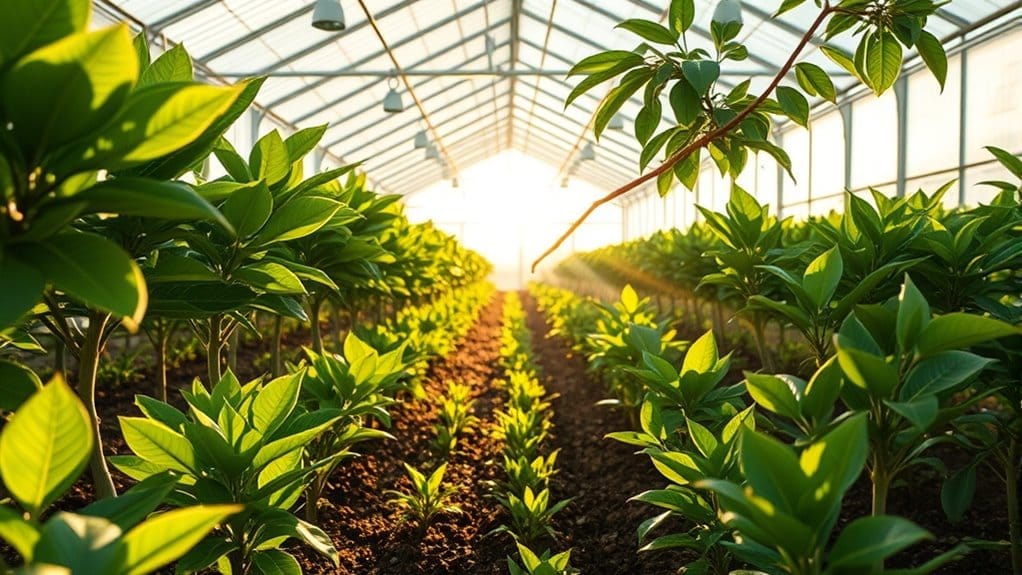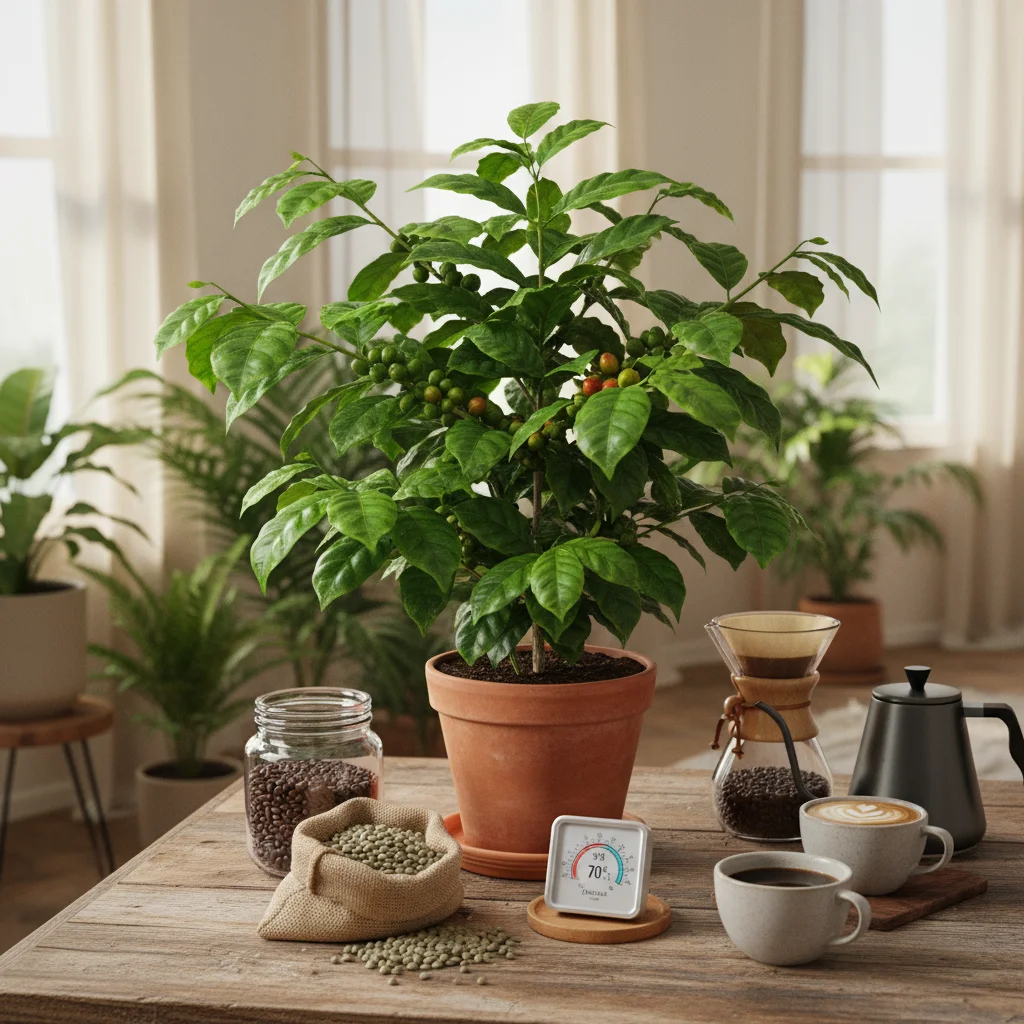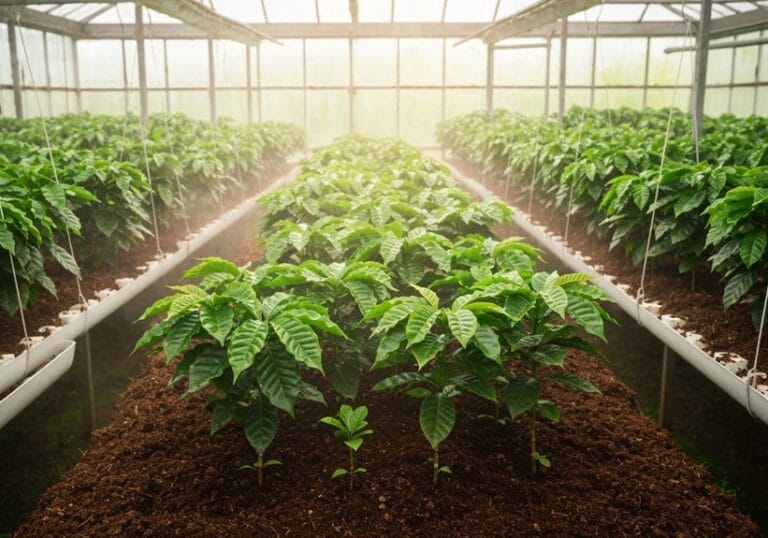So, growing coffee in a greenhouse? It’s not as easy as throwing some seeds in dirt! You need temperatures between 15°C and 24°C—don’t let those little beans see frost, or you’ll have sad coffee! Humidity around 50-60% is key, so maybe invest in a humidifier (your plants will love you!). They crave indirect sunshine too, and acidic soil is a must. Keep that soil moist, not soggy, and you’ll be brewing coffee goodness in no time! Stick around for more tips!
Key Takeaways
- Maintain daytime temperatures between 18°C and 22°C, avoiding frost by keeping nighttime temperatures above 15°C.
- Ensure humidity levels are kept between 50% and 60% to prevent mold growth and support healthy growth.
- Provide bright but indirect light, aiming for over 12 mol/m²/day, including four hours of direct sunlight.
- Use well-draining, slightly acidic soil enriched with organic matter to promote optimal root development.
- Water every few days, allowing the soil to dry slightly between waterings to avoid waterlogging.
Optimal Temperature and Climate Control
In regard to growing coffee, one might think it’s all about having the right beans, but really, it’s like hosting a picky guest who insists on a specific temperature—like, “Excuse me, but I am only able to thrive between 15°C and 24°C!” Yup, Arabica coffee is basically a diva, and if the thermometer dips below that range, it might just throw a temper tantrum, risking frost damage (and possibly calling the plant police).
Now, in terms of greenhouse grown coffee, controlling the climate is key! Keep daytime temps around 18-22°C—like spring break in a sunny locale—but don’t get too hot! Additionally, maintaining adequate moisture is crucial, so ensure your greenhouse has proper irrigation to meet the coffee plants’ needs.
And at night, don’t let it drop below 15°C, or you’ll have a meltdown—literally! So, can you grow coffee in a greenhouse? Absolutely, with a little attention!
Humidity and Airflow Management
How on earth do you keep a coffee plant happy and thriving in a greenhouse? Initially, humidity is the magic number, folks! Aim for around 50 to 60 percent—too much moisture, and you might as well invite mold to the party! Imagine your plants catching a cold—yikes!
So, grab some humidifiers and pebble trays to keep things steamy but not swampy. Next, airflow is key. A gentle breeze cools off those plants and keeps that humidity in check. Think of it as their personal bodyguard against fungal fiends!
Light Requirements for Growth

Keeping coffee plants happy with humidity and airflow is just the start of their journey—next up is light, the superstar of the growth show!
These little green wonders thrive best in bright but indirect light. Imagine placing them near a sunny window, basking in filtered glory—no sunburns here, please!
Aim for that sweet spot of 12+ mol/m²/day, or about four hours of direct sun—easy peasy, right?
If you’re in a greenhouse, let those larger canopy trees do their thing! They give off a cozy, diffused light like a gentle hug that coffee plants adore.
And hey, if the sun isn’t shining, full-spectrum grow lights can step in. It’s like hitting the coffee shop on a dreary day—everyone loves a good pick-me-up!
Soil Conditions for Healthy Root Development
When coffee plants set their roots, they’re not just digging aimlessly; they need the right soil conditions to flourish! Imagine this: a party for roots! They thrive in slightly acidic soil—like a VIP section at a concert—where they can snag nitrogen, phosphorus, and potassium. Yummy!
But hey, too much salt in the soil is like serving stale popcorn; it ruins the fun! And let’s talk drainage—well-draining soil is crucial; heavy clay? No thanks! It’s like trying to swim in molasses.
Plus, deep pots are a must; those taproots need room to stretch! So, toss in some organic matter (think compost) for good measure. Because happy roots = happy coffee! Who knew dirt could be so important, right?
Watering and Moisture Management Strategies

While it might seem simple, watering coffee plants requires a bit of finesse—like trying to dance the tango while holding a cup of coffee!
To begin with, don’t drown your plants; they’re not swimming! Water every few days, letting the top of the soil dry out a tad (they like a little drama). Use a watering can, pour it like it’s rain, and wait—yeah, patience is key—until the soil drinks it in before more flows!
And those catch trays? They’re like the coffee shop’s bottomless cup—let ‘em sip for 15 minutes but then empty that mess out! High humidity is their cozy blanket; consider misting if the air turns dry.
In general, keep it moist but not mushy—easy-peasy, right?
Frequently Asked Questions
What Coffee Varieties Are Best Suited for Greenhouse Cultivation?
Gesha, Catuai, and SL28 are preferred Arabica varieties for greenhouse cultivation due to their flavor profiles and adaptability. Furthermore, Castillo offers disease resistance while maintaining quality, making it suitable for controlled environments focused on coffee production.
How Long Does It Take for Coffee Plants to Bear Fruit?
Coffee plants typically bear fruit between three to six years after planting, although some may take up to ten years. Environmental conditions play a significant role in influencing the timing of fruit production.
Can Coffee Plants Be Grown in Containers Within a Greenhouse?
Yes, coffee plants can thrive in containers within a greenhouse. Proper container size, soil composition, and environmental conditions are essential for ideal growth, ensuring the plants receive adequate nutrients, moisture, and appropriate temperature and humidity levels.
What Are the Signs of Nutrient Deficiency in Coffee Plants?
Signs of nutrient deficiency in coffee plants include chlorosis, stunted growth, and abnormal leaf shapes. Specific deficiencies manifest through distinct symptoms: nitrogen, boron, iron, potassium, zinc, and calcium deficiencies all present unique indicators affecting general plant health.
How Should I Prepare My Greenhouse for Coffee Planting?
To prepare the greenhouse for coffee planting, guarantee proper temperature regulation, enrich soil with organic matter, install a reliable watering system, manage airflow and light, and maintain ideal humidity levels for best growth and health.





